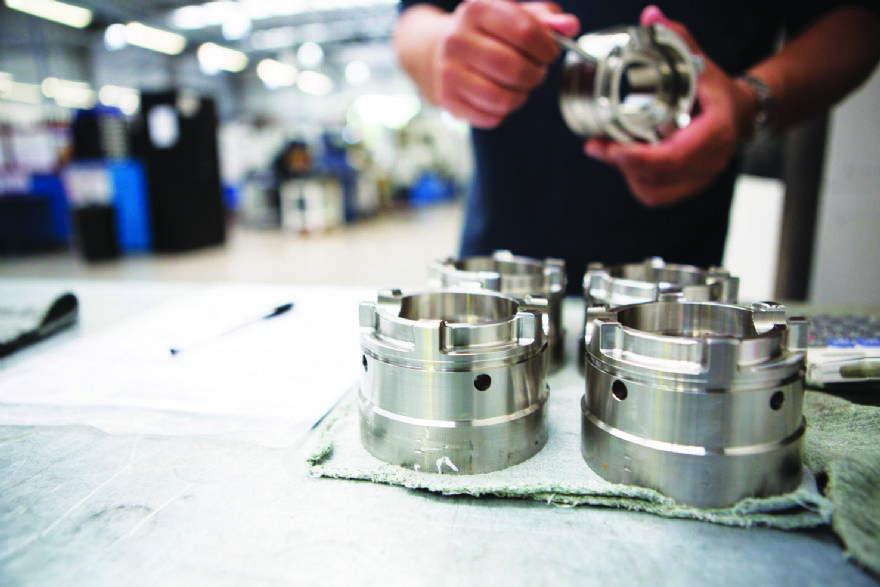
The start of the third quarter saw the UK manufacturing downturn show signs of easing. The rate of contraction in output slowed to its weakest in the current sequence of decline and business optimism rose to a five-month high. However, there remains risks to the downside, however, including persistently weak domestic and overseas market conditions, subdued customer sentiment and manufacturers concerns about the ongoing implications of the Government’s budget decisions. The seasonally adjusted
S&P Global UK Manufacturing Purchasing Managers’ Index (PMI) rose to a six-month high of 48.0 in July, up from 47.7 in June but below the earlier flash estimate of 48.2 — the PMI has signalled contraction in each of the past 10 months.
Four out of the five PMI components remained at levels consistent with a deterioration in overall operating performance (output, new orders, employment and stocks of purchases). Average vendor lead times continued to lengthen, but to the weakest extent in four months. Manufacturing production contracted for the ninth month running. However, after easing in each of the past four months, the rate of decline was only mild and the weakest during the current downturn. Both the consumer and intermediate goods sectors returned to growth following eight- and five-month sequences of contraction respectively.
In contrast, investment goods output decreased at a quicker pace than in June. Market conditions remained subdued in July. The overall level of incoming new business fell for the tenth straight month and at a quicker pace than in the prior survey month. UK manufacturers reported that both confidence and willingness to spend was weak across domestic and overseas markets. On the home front, clients remained concerned about economic uncertainty and the cost and demand implications of recent Government policy decisions (especially changes to National Minimum Wage (NMW) and employer NICs).
New export orders have now decreased throughout the past three-and-a-half years, with the latest decline reflecting global tariff uncertainties, ongoing administrative issues post-Brexit and rising competition. There were reports of lower demand from North America, mainland Europe, the Middle East, India and mainland China.
Subdued market confidenceThe combination of weak demand, rising staff costs and subdued market confidence led to a further cut to employment during July. Job losses were registered for the ninth month in a row. Moreover, rates of reduction over the past half-year have been among the sharpest registered since the pandemic year of 2020. There were reports from manufacturers of a continuing impact of the changes to NMW and employer NICs leading to cuts and hiring freezes to offset costs.
The latest survey data also suggested that the current sequence of declining staff headcounts may have further to run. Backlogs of work continued to fall despite recent cuts to capacity, with work-in-hand (but not yet completed) volumes falling at a marked pace. July also saw stocks of finished goods depleted for the sixth month running reflecting decreased production volumes, backlog clearance and stock management efficiencies. Input inventories and purchasing activity were also reduced as manufacturers sought cost savings and adapted to current demand and production requirements.
Business optimism improved to a five-month high in July, attributed to hopes for a market recovery, new product launches and operational improvements. However, sentiment remained below its long-run survey average, reflecting concerns over subdued market sentiment, challenges related to Government policy and global trade disruptions. Rates of input cost and selling price inflation remained relatively stable in July. There were reports of higher transportation, shipping and supplier costs adding to purchase prices.
Rob Dobson, director at S&P Global Market Intelligence, said: “The UK manufacturing sector is starting to send some tentatively encouraging signals, with the downturn moderating in July as factory output came close to stabilising and future output expectations hit the highest since February. However, it is clear that there is no assured path back to strong growth. Clients in the home market often remain unwilling to spend due to cost factors such as higher minimum wages and employer NICs, while export markets are being buffeted by geopolitical stresses and trade and tariff uncertainties.
“The biggest concern remains the labour market, with the rate of job cutting through much of 2025 among the steepest since the pandemic year of 2020. With the autumn budget only a few months away,
manufacturers will likely remain cautious and focused on stabilisation while waiting to see if future budget announcements provide much-needed support or further challenges to overcome.”
Continuing challengesGinni Cooper, partner at MHA, commented: ‘Although the incremental rise in today's manufacturing PMI data is, in theory, good news, more than anything, it is a further reflection of the continuing challenges faced by the sector. The PMI still remains below the 50 threshold, indicating a lack of confidence and optimism towards the future.
“Manufacturers are being hit with a double whammy. Customers are facing their own increased costs and therefore ordering less and firms are now starting to feel the full impact of the rise in minimum wage and employers’ National Insurance contributions, as it hits their profit and loss accounts.
“While the Industrial Strategy has provided a glimmer of hope to the sector, the fundamental challenges of investment and skills shortages still remain. Many clients are anticipating that next year is likely to be flat in terms of growth and confidence remains dampened which is unlikely to lead to investment in skills and technology that the sector so desperately needs. More signposting of where businesses can go for support is also required.”
She concluded: “An exception to this otherwise difficult landscape is those businesses that supply to the defence sector. Developments around the world and commitments from the UK government on defence spending mean that firms can be confident in the future growth of the sector and thus invest and expand for the future.“